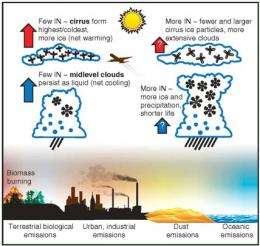Clouds + Mineral Dust = Rain

A team of atmospheric scientists, including Dr. Xiaohong Liu of Pacific Northwest National Laboratory (PNNL), found a critical link between the size of dust particles in clouds and their likelihood to produce rain.
The number of dust particles larger than 0.5 碌m in diameter had a close correlation with the number of ice nuclei, which are known to form seeds for rain droplets in clouds. This relationship allowed the team to develop a much more accurate parameterization to predict ice nuclei numbers in clouds, reducing uncertainty by a factor of one hundred.
Results from this study provide atmospheric researchers a more accurate picture of how ice nuclei form and at what temperature, so they can increase accuracy of climate models. Past predications were based on an assumption of ten times more ice nuclei present in clouds. This breakthrough follows a 14-year study from field studies at locations around the globe. This research was published in the Proceedings of the National Academy of Sciences.
The team used ice nuclei and aerosol datasets collected in nine separate studies, including field and aircraft samples. Data was gathered from areas around the globe, from the Amazon Rainforest in Brazil to the Arctic Circle. Ice nuclei number concentration data came from the Colorado State University Continuous Flow Diffusion Chamber (CFDC). During aircraft measurements, the CFDC either sampled from an ambient inlet or from the outlet of a counterflow virtual impactor that passed only cloud particle residual aerosols to the CFDC.
This new relationship is simple to apply and allows researchers to update climate models for more accuracy. Much work needs to be done in tandem with biologists to determine number and sources of these dust particles as a function of season and soil type, and on airborne particles acting as ice nuclei. The newly developed Atmospheric Measurement Laboratory, housed at PNNL, will provide an ice nucleation chamber to assist in making artificial clouds that activate particles under precisely controlled temperature and supersaturation conditions and separating these particles from the rest of the aerosol to study ice nucleation.
More information:
Provided by Pacific Northwest National Laboratory




















